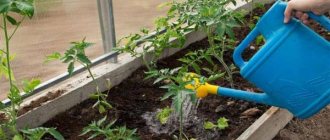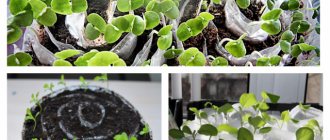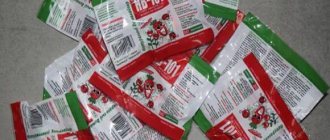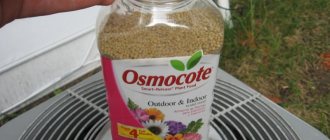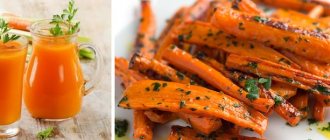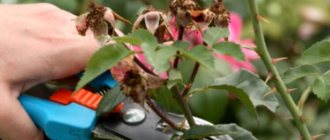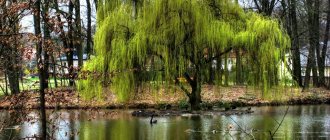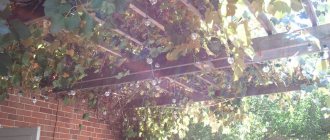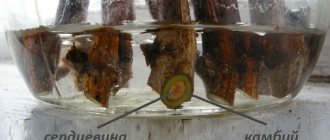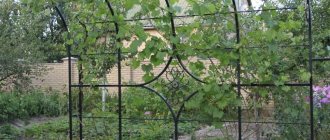Category: Vegetable garden
How to use peat tablets for seedlings correctly?
In the spring, all summer residents, gardeners and gardeners living in the middle and northern latitudes of Russia are engaged in growing seedlings, because without them it is impossible to harvest most vegetables. This can be done simply and without any problems using special peat tablets for seedlings. sadzavodi.ru will tell you how to use them correctly, plus we will give video recommendations from professionals.
Let's discuss the composition of peat tablets, their properties, as well as the basic rules for their use.
Peat tablets – what are they?
Peat tablets are pucks, usually small in size, made from compressed peat and other substances that help plants grow and develop better. In order for the tablet to have this shape, the soil is placed in the material. This is usually cellulose .
They are used for seedlings of flower and vegetable crops, as well as for plants that require special care and more fertile soil. By sowing seedlings in them, you can easily transplant the plant into the garden bed.
There are tablets of different sizes from 27 to 90 millimeters, this allows you to choose the most suitable one for your plant.
Such tablets are usually sold in specialized retail outlets and online stores; the price depends on the place of purchase and the manufacturer. When you choose, carefully examine the packaging, or even better, read reviews from more experienced gardeners.
Peat tablets have different sizes from 27 to 90 mm
How to choose the right pills
You can find peat tablets with different characteristics on sale, so it is very important to study the needs of the seedlings that will be planted in them before purchasing them:
The diameter of the tablets varies from two to seven centimeters. Naturally, when swelling they acquire different volumes. You should choose based on what will be planted: the smaller the seeds and the more tender the plant itself, the smaller the size is suitable. A diameter of 4 cm is the most universal option, suitable for almost all seedlings. Sometimes a retail chain offers only one type of tablet. If there is no choice, but you need to sow the seeds of large plants with a fast-growing powerful root system, or root a thick cutting, then you can use the material that is available. But you should regularly check the bottom of the peat tablet so as not to miss the emergence of roots and their tangling. In this case, you need to hurry and plant the sprouts in separate pots.
When purchasing tablets, it is advisable to pay attention to the structure of their filling. Some manufacturers fill them with too coarse peat fraction. This peat structure has poor air permeability, which can result in a poorly developed root system of sprouts and a predisposition to blackleg.
To fill the tablets, peat is used, which differs not only in structure, but also in acidity. It is usually indicated on the package and can vary from sour to neutral. In this case, you should know well the preferences of the plants that will be sown or planted for cuttings. If you do not pay attention to this fact, purchase peat tablets with high acidity for vegetable and ornamental crops, and neutral peat tablets for conifers, then this will greatly slow down their germination and growth, even to the point of seed death. Because of this important factor for the effectiveness of the final result, it is not recommended to purchase tablets in bulk, without packaging with all the necessary characteristics indicated on it.
You should choose peat tablets in special meshes, which not only keep the contents from spilling after being saturated with water, but are also impregnated with fungicides that prevent a number of diseases. A cheaper option, without a special shell, loses its integrity after absorbing water and turns into a shapeless lump of peat.
Description and characteristics
In fact, peat tablets are humus; they contain a lot of useful natural substances that help plants grow strong and healthy. Rotten mosses and other various plants from swamps are the main composition of the tablets
In addition to natural components, nutritional, mineral and antibacterial additives are added to the tablets, as well as various growth stimulants and fungicides, which prevent the development of various diseases.
The tablet is secured with non-woven fabric, this is necessary so that the tablets keep their shape and do not fall apart.
The puck has almost ideal acidity, it is indicated on the packaging; you need to choose it based on what plant you are going to sow in it. Each plant requires a certain level of acidity, sometimes this level is very difficult to achieve, and this is what the peat tablet was created for.
Peat tablets do not deteriorate, which means that they can be stored for a long time without spoiling.
The size should be selected for a specific plant, or rather the size of the seed. Peat tablets have sizes from 2.5 to 9 cm, this was mentioned earlier, but, in addition to size, they also have different thicknesses, from 8 mm to 3 cm. Most often, a tablet measuring 4 cm is used, but smaller washers are suitable for small seeds . If the seeds, on the contrary, are very large, then use a 7 or 9 cm tablet, since the larger the seed, the more nutrients it needs.
The most popular are peat tablets with a diameter of 4 cm
What are the benefits of peat tablets?
Why are they so loved and recommended by many gardeners? First of all, I would like to note one general positive point - this miracle thing can simplify the growing process for the gardener.
If we look at the positive aspects in more detail, we can understand that the benefits of using peat tablets are very tempting:
- They already contain useful, nutritional elements . For example, they contain trace elements, minerals, growth stimulants, antibacterial substances, and humus. The elements and substances contained in the composition are a good start for seedlings and therefore they can do without additional feeding in such a container.
- Optimal acidity level . Seedlings grow well in peat washers due to the comfortable and suitable acidity level.
- A bag made of non-woven material helps maintain shape . The product tends to swell and increase in volume, thanks to the bag that does not tear, the tablet maintains the desired shape.
- They have excellent moisture and breathability properties . The material is able to maintain an optimal level of humidity, but at the same time waterlogging and rotting are excluded due to its excellent breathable properties.
- Reduced risk of developing diseases . Also, due to the above properties and composition, there is little chance that seedlings will develop unpleasant fungal diseases.
- Products do not have a specific shelf life . If you keep them in a dry, warm place, they will retain their beneficial qualities for a long time.
- Convenience when transplanting into open ground . If you replant the plant directly in a peat puck onto a garden bed, then thanks to the non-woven material, the earthen lump near the rhizome will retain its integrity and it will be more convenient for you to deal with it.
By the way! Many gardeners have noticed that if seedlings are transplanted into open ground along with a tablet, the survival of young plants occurs faster and better.
In general, I would like to summarize, thanks to all the listed features, it is very convenient to germinate plant seeds in the products, the seedlings are perfectly formed, and the roots of the seedlings develop. And due to the fact that the seeds will be immersed in a favorable environment, the number of sprouted seedlings will be increased. And since many gardeners buy seed material in reserve, fearing that not all seeds will germinate, the gardener will be able to save on purchasing fewer seeds.
Beneficial features
Peat tablets are an incredibly useful and convenient thing for every gardener and gardener. They help solve many problems, but, more precisely, there are several main advantages:
- By sowing seedlings in tablets, you save time, you do not have to make the soil yourself;
- Peat tablets don't cover all your windows, so you don't force all the window sills in the house;
- The tablets guarantee uniform germination of seedlings and optimal soil composition for high-quality nutrition;
- Prevents the development of any diseases, since the environment inside the tablet is completely disinfected;
- A nutritious and healthy environment allows plants to grow more powerful and healthy;
- Due to the fact that the soil in tablets is well compressed and reliably protected by the material, you can keep your window sill constantly clean.
The peat tablet combines all the conditions for the plants to grow strong, healthy and beautiful.
Composition and properties of peat tablets
It is no secret that seed sowing is not the best solution for most Russian regions due to the high risk of return frosts. And if you are not lucky enough to live in the south with its more benign climate, then you have to tinker with seedlings. And everything would be fine, but not every garden plot has good soil that can be loosened, and some fragile seedlings take a very long time and have difficulty adapting, or even die.
Of course, this is not a reason to refuse to grow fruits, vegetables and garden crops, because there is a fairly simple solution to the problem, which is to use peat tablets that loosen the soil efficiently. In fact, we are talking about the same peat, only pressed into peculiar pucks in a soluble mineral shell that fixes them.
Meanwhile, the use of such washers, which in most cases are simply placed in the holes along with the seedlings, allows you to achieve good results in several directions at once. And, first of all, we are talking about high-quality aeration of the upper soil layer, which can be achieved by significantly lightening its structure. This simple technique will allow you to avoid constant mechanical loosening of the beds, although, of course, in this regard, the tablets provide only a temporary effect.
The second and, perhaps, the most important property of such raw materials is that it ensures much faster germination of seeds in open ground or in seedling boxes and flowerpots. The root system of plants also develops much better with peat tablets, which is especially important for seedlings grown on a windowsill and purchased seedlings. Returning to seed germination, it is worth noting that in light peaty soil it is not at all necessary to pick after the first division of the sprouts, which also allows minimizing the efforts of gardeners.
Pros and cons of growing seedlings in peat tablets
Pros:
- There are no strict restrictions on use;
- Small seeds can also be sown into tablets;
- No feeding is required, the tablets contain all minerals, vitamins and nutrients;
- It is ideal to grow plants in tablets that die when picked;
- Cuttings are also rooted in tablets;
- When you plant plants in open ground, the roots will not be damaged;
- There is no need to fertilize the plant;
- Humidity is controlled naturally so roots don't rot;
- The shelf life of the tablet is unlimited.
Minuses:
- It is necessary to monitor the level of humidity in the tablets; do not allow them to dry out;
- Tablets are not the cheapest method of seedlings.
Peat tablets, like any other method of planting seedlings, have their pros and cons, only you can choose how to sow your seedlings.
Agricultural technology for growing seedlings
- Before sowing, prepare the landing site. To do this, the feed cylinders are distributed over the recesses of the container.
- Then fill with warm water: each separately or all together, from a tray. Water until the substrate is saturated with moisture and the cylinders are completely swollen.
- By the way! In order not to rack your brains about how much water to pour, you can pour more and leave for 20-30 minutes. Afterwards, drain the excess water from the pan and begin sowing the seedlings.
Good to know! If you fill the tablets with cold water, they will take longer to swell. Warm moisture is absorbed faster, cold moisture takes longer.
If for sowing they use not special containers with individual recesses, but ordinary containers, make sure that the cylinders are located at a distance from each other. Otherwise, the roots of the young growth will intertwine, connecting the landing sites to each other.
By the way! The tablets can be placed in a box, any container or container filled with small pebbles or coarse sand. The mixture of the coarse fraction will control the amount of moisture and remove excess moisture during overflow. This will save the plant roots from fungus and putrefactive bacteria.
- When all the cylinders are well saturated with moisture and have increased in volume, 1-2 seeds are placed in the central recess of each. Each one is buried at a distance equal to the length of two sowing units.
- If the seed is large, it is covered with a substrate on top. In other cases, there is no need to sprinkle anything on top.
- Very small, especially rare, valuable seeds can be sown in the following way. Scatter the seed material on paper of a contrasting color with the seeds. Afterwards, pick up each seed with a damp toothpick or thin stick and place it in the planting hole.
- Seeds in granules need to be well moistened after planting. When the shell becomes limp, you should carefully spread the seed granular material over the recess.
When sealing is completed, the container is covered with a transparent lid or plastic wrap. Place them in a warm place, protecting them from direct sunlight until they hatch.
Crop care
Greenhouses with crops are provided with the optimal conditions required by the germinated plant. These are temperature conditions, humidity levels and lighting.
- Monitor the humidity level in the planting container daily. Peat cylinders dry out quickly; they must be constantly moistened by adding melted or settled water to heat. Until the planting material emerges, until the sprouts have become stronger, you cannot pour water directly onto the washers. Moisture should be sprayed from above with a spray bottle, or poured in drops. Or immediately pour water into the pan so that the landing area is saturated with moisture from below. Excess water must then be drained. Otherwise, all the work will go down the drain.
- The planting is regularly ventilated by opening the lid or removing the film. Until the seeds hatch, it is enough to ventilate for 30-60 minutes. After germination, the lid is removed more often and for a longer period.
- If the container is on the south, southeast or southwest side, but there is still not enough light, you need to think about additional lighting. This is especially true if the planting is located on a dimly lit windowsill. To do this, during the day the beds are illuminated with special phyto or LED lamps. If the daylight hours are too short, the backlight is left on at night.
- Seeds and seedlings are very sensitive to cold and temperature changes. If the window sill is cold or there are drafts, place foam rubber, polystyrene foam or a wooden board under the container. If there are drafts, the planting is removed to another place. Otherwise, the seedlings may get sick and die. It is unacceptable to leave a container with crops and growing young animals near central heating radiators, heating devices, or fire sources. Dry air is destructive for crops and young shoots. Low humidity is just as destructive for bushes as excess moisture.
- Young animals that have grown and become stronger need to be hardened before being transferred to a permanent place. To do this, the container is regularly taken out into the fresh air or a window is periodically opened next to the windowsill where the mini-greenhouse is located.
Important! Before pecking the seeds, make sure that condensation does not accumulate on the inner surface of the lid or covering film. If drops do form, carefully shake them off and blot with a clean napkin.
Advice! When installing backlights, take into account that the light should be directed similarly to the sun, that is, from top to bottom. The distance from the lighting fixture to the seedlings should be 27-40 cm. The number of light sources is determined based on the area of the bed. To illuminate 1 m2, you need a lamp with a power of at least 70 kW.
Is picking necessary? If the seeds are sown one at a time, then no. When 2 seeds were planted in each hole, then yes. A large, viable sprout is left, and the weak one is removed.
Transshipment
Depending on the rate of germination of planting material and the growth of seedlings, the young plants are transferred directly to open ground or transplanted into separate pots with a nutritious soil mixture.
- The moment of transshipment is very easy to determine. If the roots of the seedling have entangled the entire puck in a net and begin to seep through the shell, then it’s time to replant.
- Replant together with peat humus or spit tablets into pre-prepared holes or pots. The remaining voids are filled with a nutrient mixture. Pour in enough so that the soil level is level with the top edge of the washer.
Beginner gardeners often wonder: do they need to remove the casing from the cylinder or not? You can do this, but it is not necessary. Even if you do not remove the shell, the roots of the growing seedling will gradually pierce through it. The presence of a net prevents young bushes from fully developing and mastering the soil.
For which crops is it best to use peat tablets?
All plants can be sown in peat tablets; there is no crop that does not like such a nutrient medium. Since these washers contain all the necessary elements for growing healthy and powerful plants, they are suitable for all crops: berries, flowers, vegetables, etc.
It is difficult to plant small seeds in common containers, so tablets of small diameter have been created for them.
There are many plants that die when picked; in this case, you can use a peat tablet, since the seedlings in it do not require transplanting into separate containers. Also, a weak root system can be an obstacle to planting; tablets will help not damage it and ensure successful planting.
Manufacturers make tablets with different compositions so that you can choose the puck specifically for your plant.
Introduction
Before the advent of special means for growing seedlings, many gardeners faced problems, since it was necessary not only to prepare the soil for planting, but also to take care of containers for the plants. Both large boxes and individual pots were used as containers.
Peat tablets with seedlings
In addition, few people seriously thought about using any specialized means for growing, using almost any container as containers - from juice boxes to cups of dairy products. Naturally, the characteristics of such devices for seedlings were not very high.
Seedlings in peat pots
A compromise solution was to use peat pots, however, they had a number of disadvantages inherent in conventional containers. In particular, the dense material from which they are made did not dissolve well in the ground, and often, transplantation into open ground was carried out without a peat pot, since an earthen lump was removed from it, as if an ordinary container was used.
In addition, the peat pot did not provide any nutritional benefit. Practically not subject to decomposition from water, it could not transfer the nutrients it contained to the seedlings.
Peat tablets are the next step in the evolution of peat pots. They are containers that have a flattened cylindrical shape. The composition of such “washers” includes peat and various additional substances. These substances can be stored for a long time in compressed form without losing their properties.
Peat tablets
Before using it as a planting site for seedlings, the peat tablet is watered with warm water, swells and becomes loose. After this, you can plant seeds in it.
High-quality composition
Manufacturers make tablets with different compositions so that you can choose the puck specifically for your plant.
- Sphagnum peat
A complex of vitamins and minerals are added to sphagnum peat tablets and then coated with cellulose.
- Humus and peat tablet
This tablet contains mineral fertilizers, microelements and growth stimulants. Antibacterial drugs are also added here to prevent root rot.
- Premium peat tablets
These tablets are made from premium peat, and minerals and vitamins and growth stimulants are also added to them.
- With fungicides
Here the matter is treated with fungicides, this is necessary in order to prevent various kinds of diseases.
Seedling cassette with peat tablets and tray
Advantages and disadvantages
Peat tablets open up wide opportunities for gardeners in growing seedlings and greatly simplify this process.
Advantages:
- There are no restrictions on the use of tablets. Since almost all types of seedlings use soils containing peat, the use of peat briquettes will not cause any undesirable reactions in plants.
- Using tablets you can germinate small seeds. It is advisable to grow a huge number of both garden and ornamental plants in fine soils due to the size of their seeds. The peat fraction in tablets is quite small, so it is ideal for such purposes. In addition, there are crops with small seeds that need to be planted on the surface of the soil without deepening them at all. This works best on a completely peat substrate. In addition, the increased concentration of nutrients in peat guarantees a high percentage of seed germination.
- Seeds for some crops can be either expensive or difficult to obtain. Therefore, to guarantee their germination, it is better to use completely peat soil.
- No problems when picking for crops that either have a weak root system or do not tolerate transplantation well. The use of tablets allows you to carry out the operation of transferring seedlings into the ground without any injury to the root system.
- Leaf and stem cuttings take root well in them. This is much more convenient, faster and more reliable than using a solution of water with nutrients to root cuttings.
- Containers with tablets take up much less space than boxes with seedlings. Moreover, the amount of nutrients necessary for plant growth is even greater than in any soil mixture.
- The costs of time and materials for preparing planting soil are significantly reduced. In addition, the likelihood of bringing any contamination into the room where the soil mixture is prepared is reduced to almost zero. This is especially true in apartment conditions.
- With this method, seedlings are provided with a sufficient amount of air for the root system.
- For seedlings grown in this way, there is no need for any feeding or fertilizer. All the necessary nutrients are already contained in the substrate.
- The root system of seedlings when using a peat substrate is much less susceptible to rotting. The reason for this lies in the fact that peat does not absorb excess water. We can say that the control of substrate moisture occurs on its own. With this method, seedlings are guaranteed to be protected from problems such as root rot and blackleg.
- The shelf life of peat tablets is practically unlimited.
- Even a novice gardener or gardener can use this method of germinating seedlings.
Flaws:
- High price. Their use is not practical for mass cultivation of cheap crops.
- Peat tablets dry out relatively quickly. Which means constant monitoring of their moisture level and fairly frequent watering.
It is obvious that the positive aspects of using peat tablets more than outweigh the possible disadvantages. In cases where seedling material is of value to the gardener, their use is not only justified, but necessary. The use of these tools can significantly facilitate the gardener’s work and make his work more enjoyable and fruitful.
How to use - instructions
Peat tablets must be used correctly to get the most benefit from them for both you and your crops.
Preparation of planting material
Before sowing seeds, they must be disinfected; to do this, soak them in a potassium permanganate solution for 15 minutes. Also, if you have seeds without a nutritious shell, it is recommended to soak them in an infusion of wood ash.
It is also necessary to monitor the quality of planting material when purchasing. Be sure to inspect the packaging and read the information on the back.
Preparation of peat tablets
Before directly sowing the seeds, the tablets must be placed in a plastic container, making sure that the recess of the tablets faces upward.
There should be drainage holes at the bottom of the container to help prevent moisture stagnation.
Also, the plastic container needs to be placed on a tray from where you will drain excess water.
Peat tablets need to be filled with warm water and wait until they completely absorb it. Try to pour water so that the top layer of soil is not washed away.
Scheme for planting seeds in peat tablets
Peat tablets do not require any complex actions or manipulations. Make a small hole and place the seed there. If you have very small seeds, you can plant several in one washer.
If you are planting seeds in a shell, then you need to drive them a little into the soil with your finger, this will help the nutrients penetrate deeper into the soil.
To sow larger seeds, you need to enlarge the hole in the center of the tablet. They also need to be sprinkled with disinfected soil.
After you have filled all the tablets in the container with seeds, you need to cover it with a film or a lid to create a greenhouse effect. Place the container in a warm place, with a temperature of 22-25 degrees.
Features and Benefits: How to Use Peat Tablet
Peat tablets are suitable for growing various garden and flower crops that are grown in seedlings. For plants that negatively tolerate picking processes and have delicate and fragile roots, peat tablets for seedlings are best suited.
The tablets consist of pressed peat packed in a shell. The peat composition can consist of the top layer of peat soil or be made from a mixture of peat, humus, mineral and organic fertilizers with growth stimulants. For the entire period of growth and development, the young plant will be provided with all the necessary substances in peat tablets for seedlings:
- the peat humus composition of the soil promotes the full development of the plant;
- an antibacterial additive in the soil will not allow fungi and mold to develop, and the plant is completely protected from diseases;
- minerals stimulate the growth and formation of a healthy root system of the future plant.
The tablet is a container with pressed primer in a mesh shell made of non-woven fabric. The mesh allows you to keep the soil from scattering and forms a small pot. On sale you can find tablets that differ in the diameter and height of ready-to-use pots. Peat tablets have a diameter from 2.4 to 9 cm. The height of a finished peat pot ranges from 2 to 8 cm.
The acidity level of the peat filling in the tablet is neutral, with an average of 5.4 pH. It may be slightly shifted towards increasing acidity, but not exceed 6.2 pH. Vegetable plants are grown with an acidity level closer to neutral. Flower seedlings are grown in a more acidic environment. This must be remembered when choosing peat tablets.
The top of the peat tablet has a small depression for placing a plant seed in it. The choice of diameter depends on the crop that will grow in the mixture. To grow petunia seedlings, purchase tablets of small diameter. To grow seedlings of cucumbers, tomatoes and peppers, buy tablets with a diameter of more than 4-5 cm.
Benefits of peat tablets
Several important factors will help you make the obvious choice in favor of tableted peat.
- Space saving. Unfortunately, the surface area of window sills, shelves or racks for growing seedlings is always limited. Peat containers occupy a small area, which cannot be said about traditional methods of growing plants.
- Peat will help grow tender and fragile seedlings. The root system will not suffer from picking because it is not carried out and there is no need for it.
- Seeds placed in a peat mixture for cultivation have almost one hundred percent germination. The composition provides the plant with everything necessary for development and growth.
- A peat tablet will help the gardener regulate the required level of humidity . As needed, water is added to the pan, where it is evenly distributed.
- There is no need to keep a plant feeding calendar ; all the necessary substances are contained inside the pot.
- The peat mixture of the seedling pot is capable of transmitting oxygen, which is important for normal full development and growth. The gardener will not encounter rotting seedlings.
- Mesh material , which retains the shape of the peat pot, will not allow it to crumble. A plant in a peat tablet can be safely carried and rearranged from one pallet to another.
- Peat soil is an ideal place to grow a plant that does not tolerate various gardening manipulations: picking and transplanting, as well as expensive specimens that are sold individually.
- The cost of peat tablets is low , which means that a gardener can purchase high-quality and expensive seeds from a trusted manufacturer. After all, you no longer need to purchase soil and containers separately.
- Peat tablets do not require special preparation before planting seeds, unlike the use of ordinary soil, which must be steamed, frozen, etc.
- Unused new tablets are easy to store and take up minimal space. The shelf life of such soil is unlimited.
How to care for seedlings in peat tablets
After the first shoots have appeared, it is necessary to remove the film from the container and move it to a well-lit place.
The temperature regime must also be observed, but it depends on the specific plant.
Be sure to monitor the soil moisture; the tablets quickly absorb moisture and dry out, and this should not be allowed. Watering can be done in two ways: through the tray and directly into each tablet.
Once the plant's horse system is sufficiently developed, the plant is ready to be planted in the garden.
Plant life in peat mixture
Seeds are sown in the prepared moistened tablet. One or two seeds are placed in the hole. A peat tablet is the optimal container for growing small seeds that are specially coated with a nutrient shell.
Caring for seedlings involves timely watering. Humidity must be monitored carefully and not allowed to dry out.
To provide plants with light, the peat mesh pot can be rearranged or swapped without any problems. A plant that needs more light can be easily moved.
As the root system grows, the plant is placed in a larger container with soil composition. The mesh body is not removed. The roots grow through it without being damaged or sick.
Planting seedlings in open or closed ground is done without removing the mesh body. The mesh will gradually undergo rotting processes in the soil. When digging up the soil after harvesting, it can be removed or left.
Pallets and containers do not need to be treated with special disinfectant materials after using tableted peat. Simply rinse them with clean water and dry.
Rooting cuttings in peat tablets
There is another seedling technology - cuttings. But not many people know that it can also be carried out in peat tablets. They provide a fairly good environment for root germination. To plant cuttings, use the seed planting chart. The difference between the procedures should be only one thing: the cuttings must be kept in a solution that helps to form roots, otherwise the cutting simply will not produce any roots.
To reduce all risks of the disease, you need to disinfect the cuttings using potassium permanganate.
A mini-greenhouse is also necessary for cuttings, as well as for seeds. Therefore, cover the tablets with cuttings with film and make small holes in it.
Avoid exposing young cuttings to direct sunlight, but remember to keep them in a well-lit area.
Plants should be planted in the garden bed when the material is torn due to too strong roots.
Planting violet cuttings in peat tablets for rooting
A variety of peat “semi-finished products” for growing seedlings
An alternative to peat tablets is the recently introduced compressed coconut tablets. They are made according to the same principle, only peat is replaced with coconut fiber. Coconut fibers have all the qualities of peat tablets.
Coconut soil has excellent moisture permeability. The root system of plants in such a substrate has access to air, the fibers allow oxygen to pass through well. The moisture in coconut fiber lasts longer.
Coconut substrate has a more stable acidity level, remaining at 6.0 pH. This indicator is practically suitable for all types of plants grown in seedlings.
Peat pots for seedlings can serve as a replacement for tablets: how to use these containers and how they differ is a very pressing question. Cups are loved by many gardeners. They consist of 70% peat and 30% wood shavings.
Peat pots for seedlings: how to use once or repeatedly? The pot is used once, filling it with a nutrient mixture. The process of planting seeds occurs in the traditional way. Seedlings grown in peat cups are planted in the ground directly with the pot.
Like tablets, pots come in different diameters, heights and sizes. The pot is selected depending on what crop will be grown. The principle remains the same, the smaller the plant, the smaller the capacity.
Before using the pot as a seedling container, it can be kept for some time in a solution of mineral and organic substances. After the procedure, it must be dried and then filled with soil substrate.
How to transplant seedlings in tablets into open ground
You need to transplant sprouts from peat tablets into the open air when you see that the roots of the plant have filled the entire tablet and are clearly visible through the matter.
Prepare the bed for planting and place the tablet in the hole.
It is recommended to cut the material so that it does not prevent the roots from growing further.
If you decide not to cut the material, then it’s okay, almost all plants have very strong roots that are able to tear the material.
Rooting grape cuttings in peat tablets
Seed care
During the growth of seedlings, it is necessary to constantly monitor the moisture content of the peat by adding water to the pan. After watering, excess water is immediately drained, but not before the peat has absorbed the required amount of moisture.
Seedlings must be ventilated daily by opening the films and lids for 30 minutes. As soon as the first shoots appear, ventilation is done more often. It is necessary to ventilate, because condensation on young leaves can damage them.
Is it necessary to add fertilizing during the development of seedlings? The peat substance provides the seedlings with everything they need; subsequently, gardeners add fertilizer diluted in water, which is poured into a tray. Feeding should correspond to the needs of the seedlings. When should you add fertilizer? 2-3 weeks after germination the shoots appear. In some cases, fertilizer is sprayed onto plant leaves from a spray bottle.
After strengthening the seedlings, peat cups can be placed in individual pots. Some seedlings need hardening; to do this, they are taken out to a loggia or covered balcony for a certain time.
When is a plant ready to be transplanted into a garden bed or individual flower pot? As soon as roots appear on the side of the peat tablet, the plant can be replanted.
How to plant plants in the garden? To do this, they are placed in the ground along with a glass. The mesh on the walls will completely dissolve in the ground; there is no need to remove it first. The mesh allows the roots to sprout freely and does not restrain their growth. The plant is rooted in the soil and covered with soil, compacting it slightly.
Rooting cuttings
Pots with peat are also good for rooting cuttings. You can grow flowers from leaves in them, such as violets. To do this, prepare a peat cup, form a wide depression in the center and place a leaf or cutting. When watering, water should not fall on the cutting - pour it into a tray or plastic container.
3-4 weeks after planting the cutting, the peat container along with it is transplanted into an individual flower pot.
Instructions for use
Preparing peat tablets for planting seeds consists of the following sequence of actions:
- Peat products are sold in dried, compressed form, so they should be thoroughly soaked in water. The tablets should be immersed in a bowl of water at room temperature.
- Within 20 minutes, the peat tablets will absorb a sufficient amount of moisture. In this case, the peat will increase in size by 5 times. The shape is preserved thanks to the wrapping mesh.
- Next, place the swollen tablets on a flat surface with the hole facing up.
Fill the peat tablets with water.
Now the peat humus tablets are ready for planting seeds or rooting cuttings.
The difference between peat tablets and coconut briquettes
You can buy peat tablets and coconut briquettes in gardening stores. What is the difference? Coconut briquettes contain coconut fiber. The principle of operation of both tablets is the same.
Experienced gardeners use coconut briquettes together with peat tablets - coke substrate is poured into a tray, and peat tablet cups are placed on top. Why is coconut fiber valued by agronomists? Because it is a 100% pure environmental product without added impurities. Coconut fiber retains moisture well and prevents seedlings from being overly moistened.
Another distinctive property of coconut substrate is the prevention of diseases of seeds and seedlings, since the proliferation of microorganisms and fungi is impossible in it. Also, coconut briquettes can be used several times in a row.
Selection conditions:
- loose soil structure, which will provide good breathability;
- required soil acidity, which is suitable for a particular plant crop;
- required tablet diameter corresponding to the size of seeds and seedlings;
- the presence of mesh or paper covering.
To understand which tablets are better, you need to pay attention to the manufacturer. It is a reliable manufacturer that supplies the market with high-quality peat tablets and coconut briquettes, which do not fall apart into a pile of soil and provide the seedlings with all the necessary nutrition.
How to sow seeds?
For good germination, experts recommend sowing 2 seeds in each tablet. The seeds are planted in a small hole, and if the seeds are very small, you can use a toothpick.
Related article:
What should be the stand for seedlings on the windowsill?
Sow seeds in peat tablets
When the entire sowing process is completed, cover the container with peat “baskets” with a thick film to create a greenhouse effect. Agricultural stores sell small plastic greenhouses specifically for seedlings. They can be used to arrange peat tablets with seeds.
When growing seedlings from seeds, it is necessary to constantly monitor the moisture content in the peat. If you constantly maintain the humidity of the composition. Otherwise, the peat capsule will decrease and the seedlings will die due to lack of water. Watering should be done through a tray. The tablet absorbs enough moisture through the bottom. But if a large amount of water remains in the pan, it needs to be drained.
